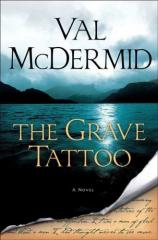The Grave Tattoo
Review
The Grave Tattoo
Why does the Bounty story fascinate us so? (Please
don’t say it’s the sight of Mel Gibson in tight
trousers and a pigtail.) From three movie versions to the
celebrated Nordhoff and Hall trilogy, from contemporary
18th-century accounts to recent historiography, the tale of mutiny,
survival and exile has been told and retold. In part I think
it’s the age-old drama of rebellion against tyranny: heroic
Fletcher Christian confronting evil Captain Bligh, setting his
former commander afloat in an open boat to make his way back to
England, then leading the crew to a refuge on the obscure shores of
Pitcairn Island. Modern interpretations, however, have corrected
the romantic might versus right version with an awareness
of class difference and historical context --- portraying Bligh not
as a sadist but as a brilliant navigator whose leadership style was
no more authoritarian than any other captain in Her Majesty’s
Navy at the time.
In THE GRAVE TATTOO we get yet another angle, albeit purely
speculative, on the Bounty. Val McDermid, best known for
her gritty, urban psychological thrillers, heads this time into
historical/literary-mystery territory, playing with the hypothesis
that Christian, who is understood to have been murdered a few years
after reaching Pitcairn, didn’t die. Instead, he escaped back
to England, where he contacted the poet William Wordsworth (with
whom he had gone to school) and told him the true story of the
mutiny and its aftermath --- which became the basis for a lost epic
poem.
McDermid’s protagonist is young, pretty Wordsworth specialist
Jane Gresham. When a reasonably intact body with tattoos from the
South Sea Islands is found in a bog in the Lake Country, Jane
realizes that it could be Fletcher Christian. Soon she is hot on
the trail of the missing manuscript, tracing it to descendants of
Wordsworth’s housemaid, who attended his deathbed. When
elderly members of that family start dying too frequently and
conveniently, THE GRAVE TATTOO takes on some of the attributes of a
more standard whodunit.
McDermid’s technique is to alternate the modern tale with
excerpts from the story Fletcher Christian told Wordsworth (she
doesn’t attempt a reconstruction of the lost poem) --- a
double-barreled narrative device I’ve encountered quite a lot
lately and of which I’m becoming a bit weary. She mixes in
plenty of subplots and subsidiary characters, too: a broken romance
for Jane; sibling rivalry between Jane and her petulant teacher
brother; the trials of Jane’s protégé, Tenille, a
13-year-old mixed-race girl with a taste for Romantic poetry (the
freshest voice in the book); the investigations of a forensic
anthropologist named River Wilde (!) and her policeman boyfriend.
There is also a good deal of rhapsodizing about the beauties of the
Lake Country, where Jane spent her childhood, but the language
often sounds like that of a travel brochure.
Unfortunately, that isn’t the only sense in which this novel
is predictable. McDermid has a couple of interesting (psychosexual)
twists on what “really” happened, but I don’t
think THE GRAVE TATTOO succeeds either as a mystery (I guessed the
villain way before the end) or a literary-historical puzzle.
Background data about Wordsworth and the Bounty is
introduced mechanically, via various handy stock characters, and
clues turn up all too fortuitously; it’s like a sketch for a
novel rather than the real thing.
This is very odd, since I have found all of McDermid’s work
up until now absolutely riveting (notably her Carol Jordan/Tony
Hill series, one of which I reviewed for this website a couple of
years ago), with fiendishly clever plots and credible, complex
characters. I’m all for authors reinventing themselves ---
it’s a shame to get stuck in a formula, no matter how
successful --- but for me this experiment just didn’t
work.
I read THE GRAVE TATTOO while staying, appropriately, on an island,
the sound of the sea crashing in the background and the smell of
salt in the air. Probably we will never know which version of the
mutiny --- because, Rashomon-like, there are several ---
is true. When men and masters are trapped on a sailing ship, miles
from anywhere, with tensions building and rage exploding, anything
can happen and, evidently, did. It’s still a whale of a
story.
Reviewed by Kathy Weissman on January 22, 2011





